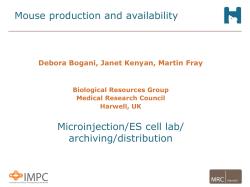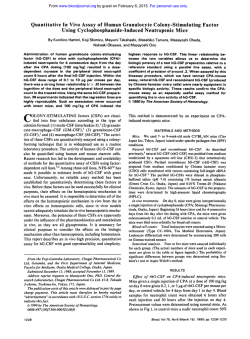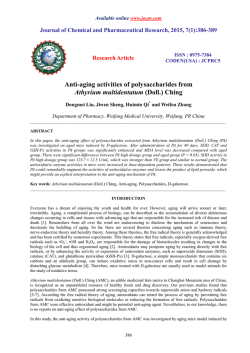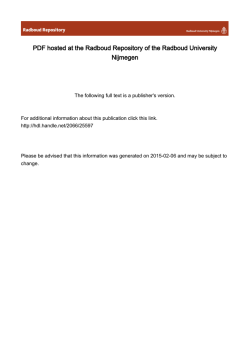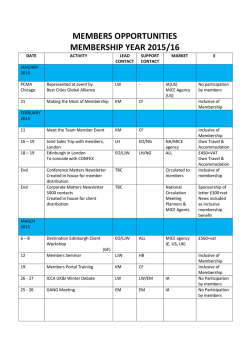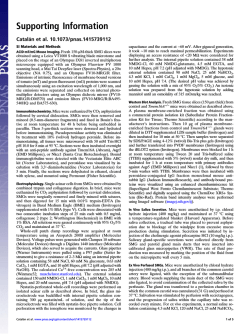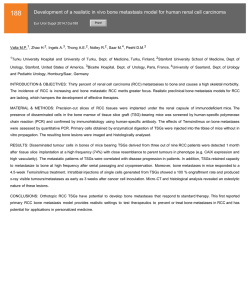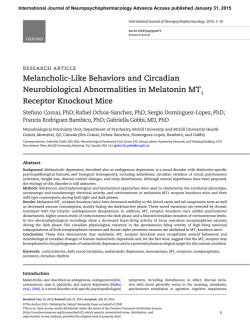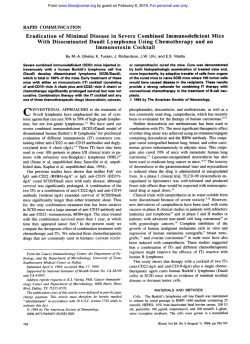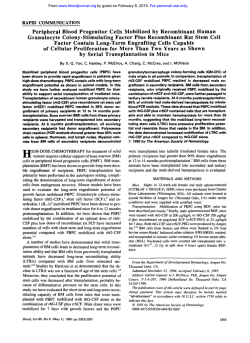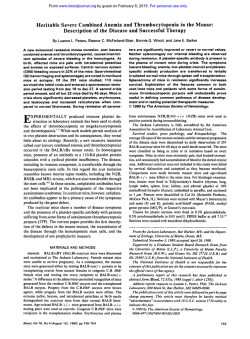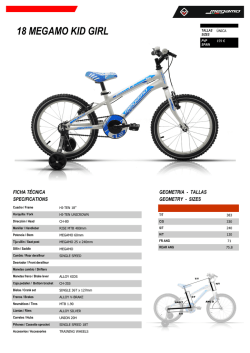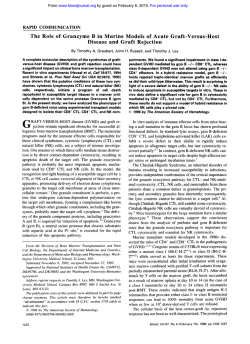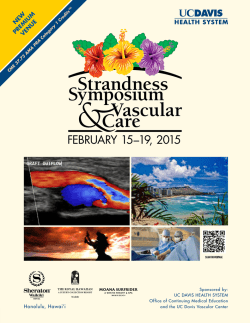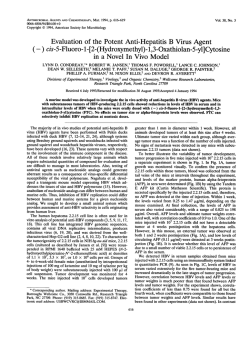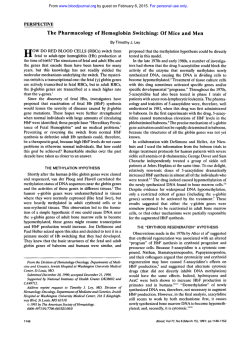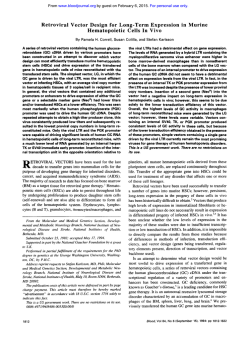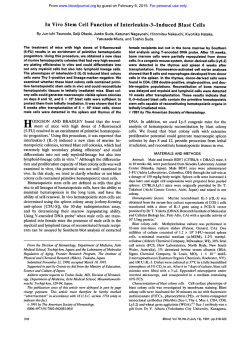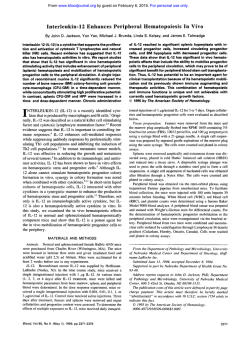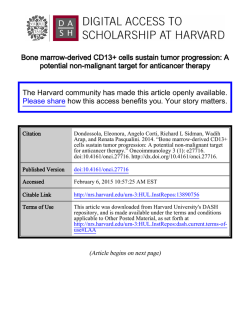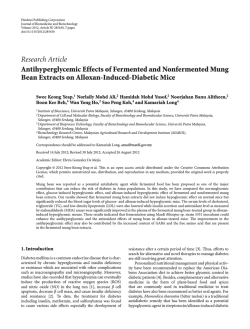
Vascular complications of type 2 diabetes and oxidative stress
THESIS FOR THE DEGREE OF DOCTOR OF PHILOSOPHY (Ph.D.) Vascular complications of type 2 diabetes and oxidative stress by Ibolya Rutkai Supervisor: Dr. Attila Tóth UNIVERSITY OF DEBRECEN KÁLMÁN LAKI DOCTORAL SCHOOL OF THROMBOSIS, HEMOSTATIS, AND VASCULAR DISEASES DEBRECEN, 2011 THESIS FOR THE DEGREE OF DOCTOR OF PHILOSOPHY (Ph.D.) Vascular complications of type 2 diabetes and oxidative stress by Ibolya Rutkai Supervisor: Dr. Attila Tóth UNIVERSITY OF DEBRECEN KÁLMÁN LAKI DOCTORAL SCHOOL OF THROMBOSIS, HEMOSTATIS, AND VASCULAR DISEASES DEBRECEN, 2011 INTRODUCTION Cardiovascular diseases in type 2 diabetes mellitus Cardiovascular diseases (hypertension, peripherial vascular disease, ischemic heart disease) are the most common health problems and these are the major causes of the mortality. The altered carbohydrate metabolism (metabolic syndrome, diabetes) and the oxidative stress may play role in/contribute to the developement of diseases. The type 2 diabetes mellitus (T2-DM) is the common name of different metabolic disorders. The diabetes charaterized by elevated glucose and trigliceride levels, impaired glucose tolerance, decreased high density lipoprotein and the associated high blood pressure. In addition the morphological changes of large vessels, such as atherosclerosis and the pathologically altered microcirculation of arterioles, venula and lymphatic vessel are play an important role in the development of cardiovascular diseases. The alterations in microcirculation contribute to the incresed morbidity and mortality of type 2 diabetic patients. Changes in the vaso regulatory mechanisms of microvessels may have significant influence on tissue perfusion and systemic blood pressure in T2-DM. However the possible underlying mechanism are still open to question. In recent years have become evidence the reactive oxygen species (ROS) in vivo significance. The cells produce a small amount of ROS in physiologically conditions, which have an important role in the regulation of signal transduction. In pathologically conditions or as a side effect of cytotoxic therapy (eg. doxorubicin) may contribute to the increased produce of ROS. Endothelium function The endothelium, which is the inner layer of blood and lymphatic vessels and an autocrin-paracrine-endocrine organ, plays role in the developement and supporting of vascular homeostasis. The endothelium reduce the platelets and leukocytes adhesion and it has antithrombotic property. There is an important role of ion and fluid exchange and contribute to the local inflammatory procces in the vessel wall. In addition a variety of stimuli the endothelium synthesize vasoactive and relaxing substances, which are regulated the smooth muscle contraction and relaxation, thereby infulence the blood flow and the tissue perfusion. In the blood flow regulation the myogenic tone, various metabolism (pCO 2, lactate, hormons), the sympathic activity and the endothelium deriving factors (NO, endothelin, prostacyclin) play an important role. The nitrogen oxid (NO) is one of the most important endothelium 1 generated compound, which is a free radical and it generated in the nitric oxide systhase (NOS) catalyzed mechanism like L-arginin and oxygen formation and breaks down quickly. Intact endothelium the production of NO is reserved by different humoral and mechanical stimuli (like as acetilcholine, histamin, thrombin, increased blood flow). The regulation of vessel diameter by NO plays an important role in arteries, veins. The endothelium derived NO can be activated the soluble guanilate cyclase (sGC), which may increase the concentration of cyclic-guanosine-monophosphate (cGMP). We confirm in vivo the role of NO in our experiments, because in the gracilis arteries, which have intact endothelium, the L-arginine analougs decreased the rate the acetil choline (Ach) derived diltation. The vascular endothelium is also produced some vasoconstrictor substance. Endothelin is the either of these and it is best known. Angiotensin II is also produced by endothelial cells and it can be activeted the G protein linked receptors via the increased intracellular Ca 2+ concentration, PKC activation, smooth muscle cell migration and proliferation. The myogenic tone Resistance vessel has an basal resting tone, named myogenic tone which permit of the vasoconstriction or vasodilation response to different stimuli, thus effectively resulting the regulation the metabolic needs of tissue perfusion. In T2-DM the developement of macro and microvascular dysfuntion the endothelium and smooth muscle dysfunction due to endothelial and smooth muscle damage. The renin-angiotensin-system The renin-angiotensin system (RAS) coordinating the hormonal cascade pathway, which has a major physiological and pathophysiological importance in renal function and vessel diameter regulation. Renin is the first component of the RAS, which is released from the kidney juxtaglomerular cells. The next step is the formation of angiotensin I. In the angiotensin-converting enzyme (ACE) catalyzed reaction issue in the active Angiotensin II (Ang II) peptid. Two of Ang II receptors, the AT1R and AT2R are the best characterized. The AT1R mediating pathways plays a role in many physiological process, such as vasoconstriction, cell differentitation, renin release. The function of the AT2R mediating pathways are even less studied, but the stimulus of Ang II induce an opposite effect int he AT2R, than the AT1R. Additionally the angiotensin 1-7 (Ang 1-7) and the angiotensin III (Ang III) have physiological role. 2 Vascular prostanoid synthesis The inflammatory is a complex response of the body for elimination of harmful effects, the restore of the normal stucture and function. The cardiovascular diseases associate with a low-level inflammation, which happen in the small arteries. These infalmmatory responses play an important role in the adaptation of alteration of the phisiological condition. The low-level inflammatory contribute to the developement of side-effect of T2-DM. The cicloosigenase a membran bound enzyme, which catalyze the arachidonic acid prostaglandin G2 (PGG2) and prostaglandin H2 (PGH2) conversation. 2 isoforms of COX enzym have been isolated in mammalian cells, like COX-1 and COX-2. While the COX-1 is a constitutive expressed till then the COX-2 is an inducated enzyme. COX-2 play a central role in the pathophsiology of inflammatory diseases, such as atherosclerosis and heart failure. In diabetes the increased level of the prostanoid synthesis lead to vascular dysfunction. Vascular cells produce many kinds of prostanoids (PGI2, PGE2, PGF2 , which have effect through the plasma membrane bindig bound receptors. Oxidative stress The reactive species have diverse effects, one of their share in the important role in physiological pathways and the other impair the cell and tissue function. Amount of reactive oxygen species (ROS) increase in pathophysiologically conditions or in the effect of cytostatic therapy (doxorubicin), which contribute to the cell and vascular dysfunction. ROS sources include the mitochondrial electron transport chain, process of phagocytosis and operation of very different enzyme (NADPH-oxidase, cytochrome oxidase, monoamino oxidase, NOS, COX and lipoxygenases) Doxorubicin and PARP-2 Doxorubicin (DOX) is a broad spectrum anthracyclne-based antitumor antibiotic used in the treatment of solid tumors, lymphomas and leukemias. Hower the severe cardiotoxicity is the biggest drawback of the DOX. The mechanism underlying the toxic effect is free radicaé production resulting from teh kinon-semikonon cycling of DOX in to the mitochondria. The produced semikinion is an instable. The DOX treatment distores of cells and may activate the poli-ADP-ribose polymerase, which lead to NAD+ and ATP depletion 3 contribute to the cell death. The poli-ADP-ribosilation is the posttranslational modification of proteins by the PARP enzymes. AIMS OF THIS STUDY Based on the previous research described in the Introduction the following aims were defined: 1. To investigate the alterations in the vasomotor function of resistance vessels in specific role of prostanoids in the genetic animal model of T2-DM 2. To charaterize the poli-ADP-ribose-polimerase funcion in the effect of doxorubicin induced reactive oxygen radicals production. 4 METHODS Genetic model of type 2 diabetes In the experiments, a well-characterized mouse model of the human type 2 diabetes was used (db/db mouse with homozygote mutation in leptin receptor). A 12-week-old, male db/db (C57BL/KsJ-db2/db2) and heterozygous (C57BL/KsJ-dbţ/db2) mice were fed standard chow and had free access to water. PARP-2 knock out mice Homozygous PARP-22/2 and littermate PARP-2+/+ mice derived from heterozygous crossings were kept in a 12/12 h dark–light cycle with ad libitum access to water and food. Mice were randomly assigned to four groups: PARP-2+/+ and PARP-22/2 control (CTL), and PARP-2+/+ and PARP-22/2 DOX-treated. DOX treatment was performed by the injection of 25 mg/kg DOX or saline intraperitoneally as described. Aortas were harvested 2-day postinjection for further assessment. Arterial blood pressure measurment Blood pressure was measured in 12-week-old conscious mice using an automated tail cuff manometer system. Cannulated microvessel technic Microsurgery instruments and an operating microscope were used for the isolation of a gracilis muscle arteriole (0.5 mm in length) running intramuscularly. The arteriole was isolated and transferred into an organ chamber containing two glass micropipettes filled with Krebs solution composed of (in mmol/L): 110 NaCl, 5.0 KCl, 2.5 CaCl2, 1.0 MgSO4, 1.0 KH2PO4, 5.0 glucose, and 24.0 NaHCO3 equilibrated with a gas mixture of 10% O2 and 5% CO2, balanced with nitrogen, at pH 7.4. Vessels were cannulated on both ends, and micropipettes were connected with silicone tubing to a pressure servo control system. Temperature was set at 37oC by a temperature controller. Changes in arteriolar diameter were continuously measured with a video microscope system. After a 1 h incubation period, 5 spontaneous basal arteriolar tone developed in response to 80 mmHg intraluminal pressure, without the use of any constrictor agent. To obtain the passive arteriolar characteristics, pressure-induced arteriolar responses were measured in the presence of Ca2 +-free Krebs solution. Isometric contractile force measurment For aorta ring studies, mice were anaesthetized by thiopental (50 mg/kg, iv). Mice were dissected after they did not respond to pain. Thoracic aortas were cut into 4 mm rings in an organ chamber and were fixed on an isometric contractile force measurement system by metal wires. Aortic rings were stretched according to the manufacturer’s instructions. Fixed, stretched aortic rings were treated with the indicated agents for the indicated times and contractile force was recorded. Myogenic tone After a 1 h incubation period, spontaneous basal arteriolar tone developed in response to 80 mmHg intraluminal pressure, without the use of any constrictor agent. To obtain the passive arteriolar characteristics, pressure-induced arteriolar responses were measured in the presence of Ca2+-free Krebs solution. Then, changes in the diameter of arterioles were measured in response to step increases in intraluminal pressure from 20 to 120 mmHg. Western immunoblot Aorta was dissected from control and db/db mice, cleared of connective tissue, and briefly rinsed in ice-cold, oxygenated Krebs solution. After the addition of Laemmli sample buffer, tissues were homogenized. Immunoblot analysis was carried out as described earlier.The polyclonal antibodies used for the detection of EP1 and EP4 receptors. Anti-bactin IgG was used as loading control. Signals were revealed with chemiluminescence and visualized autoradiographically. Optical density of bands was quantified and normalized for b-actin by using. 6 Statistic for data of cannulated vascular response To obtain the passive arteriolar characteristics, pressure-induced arteriolar responses were measured in the presence of Ca2+-free Krebs solution. Normalized arteriolar diameter (in Ca2+-containing Krebs solution) was expressed as a percentage of corresponding passive diameters (in Ca2+-free Krebs solution). Data are expressed as means+S.E.M. Statistical analyses were performed by ANOVA followed by the Tukey post hoc test. P, 0.05 was considered statistically significant. Statistic for data of cannulated vascular response Statistical significance was determined using Student’s t-test. Error bars represent SEM unless stated otherwise. RESULTS AND DISCUSSION db/db mice characterization Previously, we have found that at 12 weeks of age, body weight, serum glucose, and serum insulin of male, db/db mice were significantly elevated, compared with agematched control heterozygous animals. These alterations in the db/db mice resemble to characteristics of human type 2 diabetes. In this study, we have found that systolic blood pressure was significantly elevated in db/db compared with control mice (control: 136+4 mmHg vs. db/db: 155+ 5 mmHg), whereas heart rates were similar in the two groups of animals (control: 612+18, db/db 579+24 1/ min). Based on the aforementioned, we hypothesized that EP1 receptor activation may be responsible for the enhanced arteriolar tone and consequently elevated systemic blood pressure in db/db mice. First, the potential contribution of EP1 receptor activation to the intraluminal pressure- and agonist (Ang-II) induced arteriolar tone was investigated. Stepwise increases in intraluminal pressure from 20 to 120 mmHg elicited significantly greater constrictions in arterioles from 7 db/db mice compared with control vessels at each pressure step, a finding that corresponds with our previous observations. Ang II-induced constrictions were also augmented in skeletal muscle arterioles of db/db mice, similar to the observation in the aorta of the obese Zucker rat. These findings raised the possibility that in arterioles of db/db mice, endogenous PGE2, via primarily activating EP1 receptors, enhances pressure- and Ang II-induced arteriolar tone. It is known that PGE2 can activate four different types of G-protein-coupled receptors, which may result in either vasodilation (via activating EP2 and EP4 receptors) or vasoconstriction (via activating EP1 and EP3 receptors). Incubation with the selective EP1 receptor antagonist, AH6809, did not affect pressure- and Ang II-induced responses in arterioles of control mice, but it reduced pressure- and Ang II-induced tone in arterioles of db/db mice, back to the control level. Next, arteriolar responses were obtained to exogenously administered PGE2 (10 pM–100 nM) or to the selective EP1 receptor agonist 17-phenyl-trinor-PGE2 (10 pM–100 nM) in the absence and presence of the EP1 receptor antagonist, AH6809. PGE2, in a dosedependent manner, elicited constrictions in both group of vessels; however, the magnitude of constrictions was significantly enhanced in arterioles of db/db mice 17-phenyl-trinor-PGE2 elicited constriction of arterioles, which was also significantly greater in arterioles of db/db mice-. The EP1 receptor antagonist, AH6809, significantly reduced constrictions to PGE2 and diminished arteriolar responses to 17-phenyl-trinor-PGE2 in both groups of mice. Of note, higher concentrations of PGE2 (10 and 100 nM) elicited significant constrictions even in the presence of AH6809. These findings indicated that exogenous PGE2 causes primarily vasoconstriction in mouse skeletal muscle arterioles and that increased responsiveness of EP1 receptors is mainly responsible for the augmented pressure and Ang II-induced constriction in arterioles of db/db mice.We have found that the remaining constrictions in the presence of the EP1 receptor antagonist were completely abolished by additional administration of the TP receptor antagonist, SQ29548, in both groups of vessels (control: to 1+4% and db/db: to 23+2%). To exclude the possible contribution of a diminished EP4 receptor-mediated dilator responses. We have also found that PGE2-induced arteriolar tone was not significantly affected by the presence of the selective EP4 receptor antagonist, L-161,982, or by the presence of an NO synthesis inhibitor, L-NAME, either in control or db/ db mice. However, we have found that NO synthesis inhibitor, L-NAME, did not significantly affect arteriolar tone and constrictions to PGE2 in control and db/db mice, suggesting only a limited contribution of NO in mediating PGE2-induced arteriolar responses. Functional experiments indicated a contribution of EP1 receptors in the augmented constriction of skeletal muscle 8 arterioles of db/db mice. To reveal changes in vascular expression of EP1 receptors, western immunoblot analysis was performed in the aorta of mice. We have found that the protein expression of the EP1 receptor was significantly increased in the aorta of db/db mice, when compared with control animals, whereas protein expression of the EP4 receptor was similar in the two groups. However, it should be noted that an increased expression of EP1 receptors does not necessarily cause a greater response, as EP1 receptor signal transduction/second messenger pathways could be also enhanced, and receptors may not be present in the plasma membrane, but rather in an intracellular location. Thus, one cannot exclude the possibility that EP1 receptorinitiated signalling mechanisms are augmented in microvessels of type 2 diabetic mice, an idea yet to be elucidated. However, it should be noted that an increased expression of EP1 receptors does not necessarily cause a greater response, as EP1 receptor signal transduction/second messenger pathways could be also enhanced, and receptors may not be present in the plasma membrane, but rather in an intracellular location. To provide in vivo evidence for an enhanced EP1 receptor activation in db/db mice, the effects of an EP1selective antagonist on systemic blood pressure were assessed. Systolic blood pressure was monitored in conscious animals by the tail cuff method. After 2 days of treatment with the EP1 receptor antagonist, AH6809 (10 mg/kg/day), significantly reduced the systolic blood pressure of db/db mice, but did not affect the blood pressure of control animals. Upon discontinuing AH6809 administration, systolic blood pressure returned back to the initial, elevated level in db/db mice. PARP-2 depletion counteracts vascular dysfunction DOX toxicity affects both cardiac and vascular functions.1 In the vasculature, DOX treatment has been shown to affect endothelial function but no definitive data are available for its effect on the vascular smooth muscle and the extracellular matrix. We investigated vascular functions after DOX treatment in PARP-2+/+ and PARP-2-/- mice first. We did not detect major differences in aortic reactivity between untreated (CTL) PARP-2+/+ and PARP2-/- mice. In contrast, DOX treatment significantly decreased norepinephrine (1 M – 30 M) and 5-hydroxytryptamine (serotonin, 1 nM – 30 M)-induced contractility of the vessels in PARP-2+/+ mice, while PARP-2-/- mice were partially protected. KCl-induced (10-60 mM) contraction of aortas from PARP-2+/+ mice was reduced upon DOX treatment whereas the 9 contractile responses of aortas from PARP-2-/- mice were unaffected. These findings suggested a PARP-2-dependent deterioration of vascular smooth muscle function after DOX treatment in mice. Endothelial function was assessed by the application of acetylcholine (1 nM – 30 M). Impaired reactivity of aortas to acetylcholine after DOX treatment in both PARP-2+/+ and PARP-2-/ mice indicated that the DOX-induced deterioration of endothelial function was independent of PARP-2. Moreover, sodium nitroprusside (SNP, (10 nM – 300 M) -induced vasorelaxation was not affected by either DOX treatment or by the deletion of PARP-2, suggesting that blunted acetylcholine responses were not related to impaired NO reactivity of smooth muscle cells. We have affirmed the deterioration of endothelial function in DOX-treated animals but it seems to be independent of both PARP-2 and PARP-1, at least 2 days post-treatment. Importantly, however, early upon DOX administration, vascular smooth muscle is also damaged. We have shown that the deletion of PARP-2 provided protection against the vascular failure induced by DOX. Moreover, this protective phenotype was linked to the preservation of vascular smooth muscle. PARP-2 depletion did not modulate the DNA reakage–PARP-1 activation– cell death pathway. Therefore, it is likely that PARP-2 does not affect PARP-1 activation that may exert its deleterious effects. SUMMARY 1. In conclusion, the present study showed that up-regulation of EP1 receptors, in part, contributes to the augmented pressure- and Ang II-induced arteriolar tone in db/db mice. We propose that targeting of EP1 receptors may provide novel therapeutic modalities for the treatment of type 2 diabetes-associated microvascular vasomotor dysfunction and hypertension. 2. In summary, in this research we provide evidence for the protective role of SIRT1 in the vasculature and implicate PARP-2 as a new target to limit DOX-induced vascular damage. 10 11 12
© Copyright 2025
